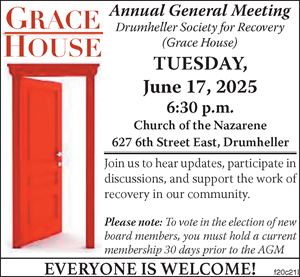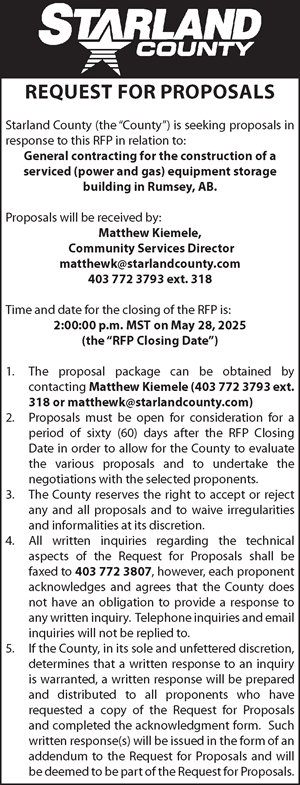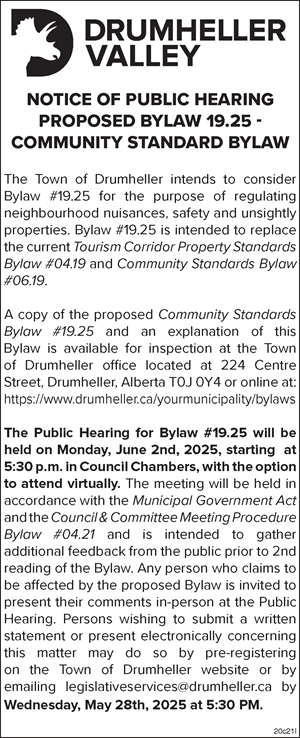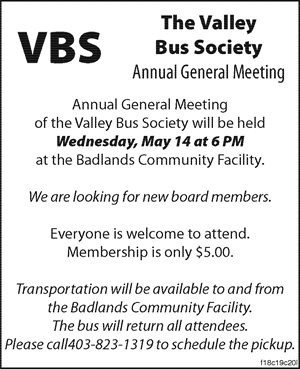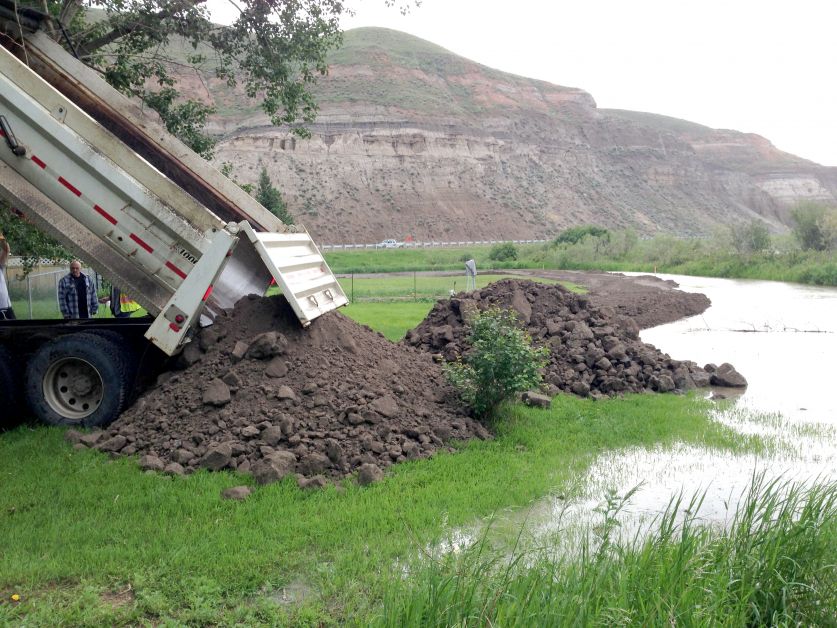
The Drumheller Resiliency and Flood Mitigation Office (DRFMO) held a remote community engagement event on Thursday, February 3 to provide information about proposed flood mitigation plans for the community of Lehigh to Drumheller residents.
Landowners previously met with town officials on Thursday, January 6, and were informed flood mitigation options for the community were not feasible due to a number of factors including safety and funding limitations.
“Flood measures were assessed by multiple engineering teams, past and present, and all those experts have come to the same conclusion,” said Drumheller Mayor Heather Colberg during the meeting. “The most recent flood mitigation analysis study was initiated by community input; this was not part of the original flood mitigation scope, it was to ensure every avenue was researched.”
Mayor Colberg noted council members, who were also in attendance during the meeting, are not experts in flood mitigation. Like many other professionals, they rely on experts such as engineers and conservationists, among others, to execute this project, which has been an ongoing effort for many years.
Flood Mitigation project director Deighen Blakely explained the community of Lehigh is at significant flood risk and was heavily inundated twice in the previous two decades--during both the 2005 and 2013 floods. Flow rates for these two floods were significantly lower than the 1,850 cubic meters per second (cm/s) which flood protection is being designed for as designated by the province.
Funding to build a berm to protect the community was previously applied for in 2014 and 2015. However, both these requests were denied as the cost to build a berm was estimated much higher than the value of the property it would protect, and residents were informed in 2016 by both the Town of Drumheller and the province no berm would be built and buyouts would be the only option, once funding was available.
The town received funding for the flood mitigation project in 2019, and in 2020 the province released its updated flood maps with the updated 1,850 cm/s flow rate.
Ms. Blakely acknowledged purchasing some 20 properties and 12 homes in Lehigh will have a significant impact on the community. Based on feedback from both citizens and council, an additional study for potential flood mitigation measures was carried out during summer 2021 with findings completed in January 2022 which revealed buyouts remained the “only feasible measure to protect people and property in Lehigh.”
Senior project engineer for Woods Water Resources Liv Hundal, who previously worked on flood berm and bank erosion projects following the 2013 flood events in Bragg Creek, and his team conducted the study. He explained there are several factors working against the community of Lehigh.
Not only is the community located in a flood-prone area, but the ground the community is built upon is also porous and permeable which would pose problems for seepage in the event of overland flooding, even with flood mitigation measures in place.
Mr. Hundal’s team looked at a variety of options for flood mitigation.
The first measure considered was dredging, widening, or straightening the Red Deer River channel near Lehigh. However, this option was not considered feasible due to the amount of material required to remove, the negative effects this would have on the aquatic habitat in this area which would pose permitting issues with Alberta Environment and Parks (AEP) and the Department of Fisheries and Oceans (DFO), and the ongoing costs to maintain these changes due to silt build-up over time.
He also noted these options would only reduce flood levels by some 10 centimetres.
Both permanent and temporary berms or barriers were also considered, but these options were not considered feasible.
A permanent berm structure would need to be built to some three metres high and over a kilometer (1,250 metres) in length, ringing the community both upstream and downstream. Due to the porous and permeable nature of the ground, seepage would still pose a significant problem.
While seepage does happen in other areas, such as Newcastle, there is a greater degree of risk in Lehigh. A permanent structure is also preliminarily estimated at some $4.8 million which is a much greater value than the property it would protect. Mr. Hundal noted while cost was not the primary factor in considering this option non-feasible, it was taken into consideration.
Temporary flood mitigation structures, such as water-filled dams or dirt berms, were also not considered feasible due to seepage. They are also difficult to deploy to the scale needed to protect the community within the “tight timeframes” of an imminent flood event.
Funding, both at a provincial and federal level, are not available for these options.
Mr. Hundal’s team also considered raising structures and critical utility infrastructure, similar to what can be seen in New Orleans, above the projected 1,850 cm/s flow rate. There would still be a significant risk of damage to properties due to cars and other structures which are below the flood level, and would still pose an increased risk to residents and first responders in a flood event.
Mr. Hundal explained doing nothing and keeping Lehigh at the status quo was also “problematic” in the long term; the area has been zoned as a floodway by AEP, and the Town of Drumheller's bylaws prohibit any future development in this area. Based on the updated flood mapping from the province, Disaster Recovery Program (DRP) funding would not be available to residents unless the flooding was above the 1,850 cm/s flow rate, limiting funding.
Properties are limited to a one-time payout to a maximum of $500,000 and a caveat is placed on the property which carries through future owners. Once a payout is received, no future payouts--whether for the same or a new owner--will be approved.
Alberta Emergency Management Agency executive director Colin Blair explained the average payout in Drumheller following the 2013 flood was only about $4,300.
These factors left the only viable option as buyouts, and Mr. Hundal noted the provincial government has approved a total of some $20 million to complete property buyouts as part of the flood mitigation program, of which $17.66 million was approved by council for purchase and $2.34 million for legal and land assessment fees; to date, 11 properties have been purchased for a total of $4,737,160 and an additional $668,000 has been spent on associated administration fees such as legal and land appraisal, totaling some $5.4 million. This amount will also include such expenses as remediation in affected areas.
“The truth is no, we cannot feel your pain, we cannot feel your hurt, and we do not feel your sense of loss,” Mayor Colberg expressed. “We wish there was a different way. However, every study, going back years, is saying the safe thing to do is to get you to high ground. The province has given the funds to get you to a safe place, and they have given them now while your home, your biggest asset, still has value.”
Ms. Blakely explained these properties bought out “must be designated as Environmental Reserve” and the flood mitigation team has negotiated with the province to ensure landowners will receive current market value--the greater of appraised or assessed value--and currently, more than half of these properties have been appraised 50 per cent greater than their assessed value.
She provided a timeline on the buyout process, explaining landowner one-on-one discussions and meetings will be ongoing until June 2022. Negotiations have already begun with willing sellers and will continue through June 2023 with landowner relocation expected to take place between July and December 2023; the land will be reclaimed and designated as Environmental Reserve in spring 2024.
During a question and answer period, several concerns were brought up, including the future use for land in the Lehigh community and whether future structures would be built by the town. Drumheller Chief Administrative Officer (CAO) Darryl Drohomerski explained once the land is designated as Environmental Reserve it cannot be changed back without ministerial approval.
Mr. Drohomerski also acknowledged Drumheller taxpayers will shoulder the loss of properties in Lehigh, though noted it is not limited to only this community; properties in the floodway in Rosedale, Newcastle, and Nacmine are also being bought out and the goal is protected properties will increase in assessment and help stabilize the tax base.
A number of vacant town-sized lots--between 6,000 and 8,000 square feet--are available for interested Lehigh residents. At this time the town has been unsuccessful in negotiating purchase of privately held land to accommodate acreage-sized lots for displaced residents.
Another concern brought up was how Mr. Hundal’s team assessed groundwater flooding as this was limited to three drilled boreholes. While Mr. Hundal confirmed three boreholes were drilled, this was not the only information used to determine the risk of groundwater flooding. His team also had access to records for groundwater wells in the community. Between these records and information obtained through borehole drilling, his team was able to calculate ground conditions throughout the community.
The full Lehigh comprehensive flood mitigation analysis study can be found online at floodreadiness.drumheller.ca










